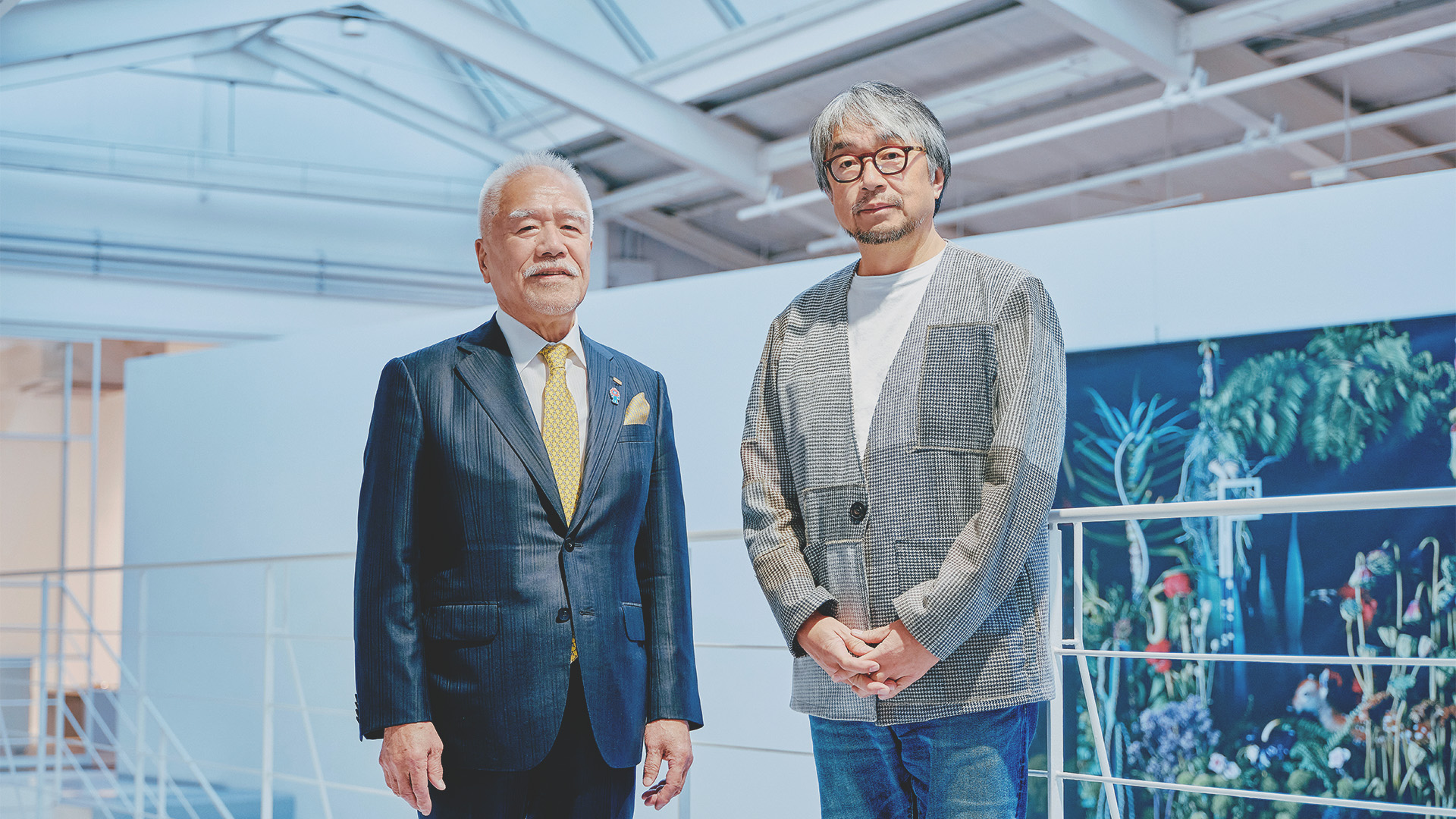
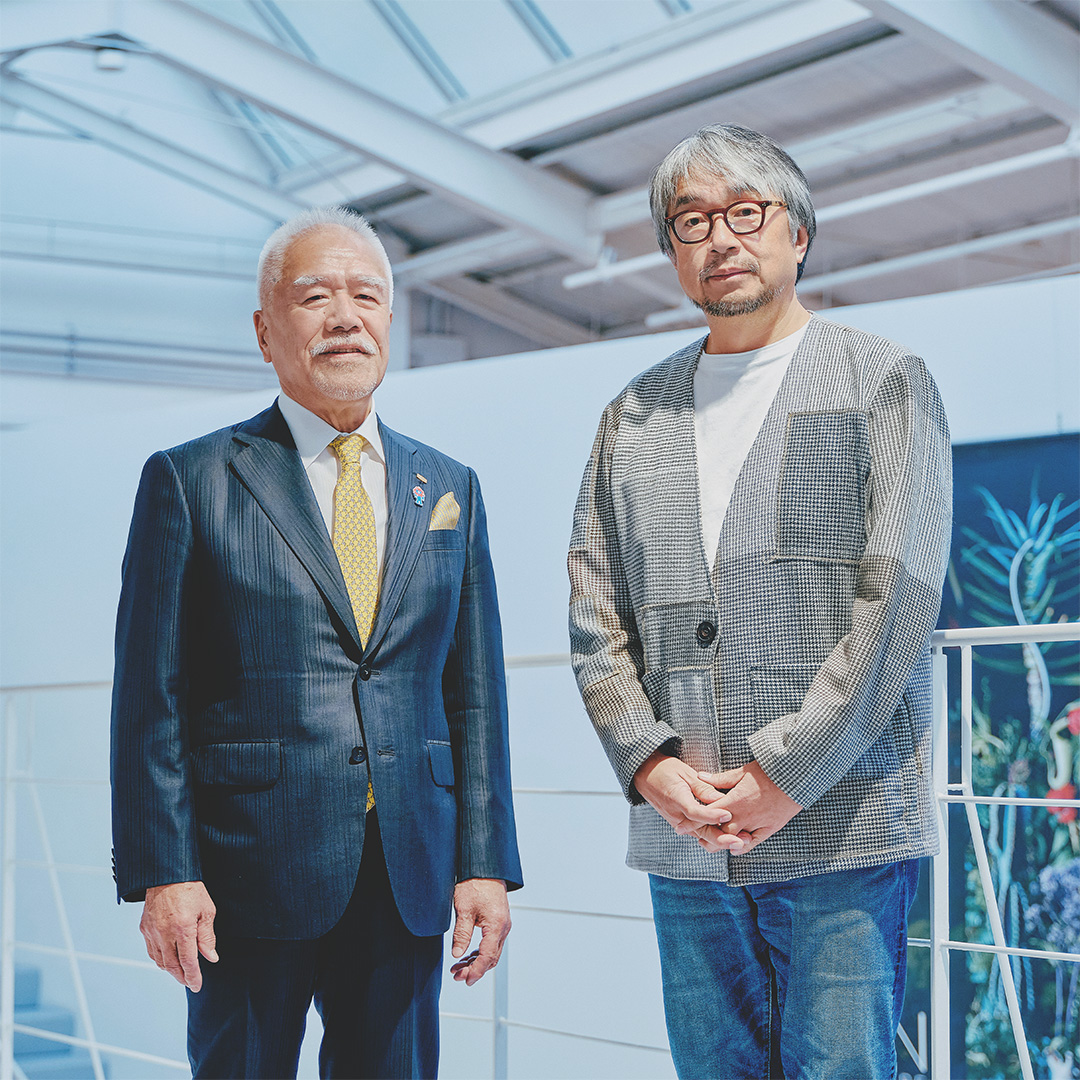


Junzo Tateno
CEO of UNION Corporation
Born in 1947, Junzo Tateno graduated from the Faculty of Law at Konan University (Kobe, Japan) in 1970
and entered Aoki Construction that same year. He joined UNION in 1973 and became CEO and President in 1990.
He serves as Chairman of the Union Foundation for Ergodesign Culture, a Public Interest Incorporated Foundation,
and the Osaka Industrial Bureau. He is also Vice Chairman of the Osaka Chamber of Commerce and Industry.
Kundo Koyama
- Television writer / screenwriter
Born 1964 in Amakusa City, Kumamoto Prefecture, Kundo Koyama is Vice President of Kyoto University of Arts and owner of the Japanese restaurant Shimogamo Saryo. He has planned many food-themed TV programs, including Iron Chef, Palais de Z, and Remote Chef. His film Departures (Okuribito) won the Best Screenplay at the 32nd Japan Academy Awards and Best Foreign Language Award at the 81st Academy Awards. In addition to his writing activities - which include dancyu’s Ichishoku Ikon magazine series - he also serves as a regional and corporate Project Advisor, as a judge for Cooking Masters (sponsored by Japan’s Ministry of Agriculture, Forestry and Fisheries), and as General Producer of RED U-35, one of Japan's largest chef competitions. Koyama is also the creator of Kumamoto Prefecture's mascot character ‘Kumamon’. He is currently Producer of the ‘EARTH MART’ signature pavilion at Expo 2025 Osaka, Kansai.
21
TATENO
Firstly, please tell me about yourself at the time of the 1970 Osaka Expo.
KOYAMA
I was 6 years old at the time.
TATENO
Do you have any memories of the Expo?
KOYAMA
I don't remember much because, at the time, we were living in Kumamoto and never went. The only vague memory I have is of my grandparents going to it. They came home carrying what must have been a souvenir bag. How about yourself?
TATENO
I was already in Osaka by then, so I went to the expo site often.
KOYAMA
That's nice. I imagine you felt it was like going across to the park to play.
TATENO
Yes, it was local, so I felt we were just stopping by. But in 1970 the Expo wasn't very popular at the start.
KOYAMA
So, it appears. I didn’t know that until recently. Back then there was a phrase, "Osaka anti-expo." There were also demonstrations. Did you hear about the so-called ‘eye-jacking’ incident? A young man holed himself up inside the eye of the Tower of the Sun.
TATENO
Yes, I remember that.
KOYAMA
I saw an interview in which [the Tower’s creator] Taro Okamoto appeared while the protester was still occupying the eye and said, “That's a clever idea. You have made the tower an anti-Expo symbol. Hey, you in there. You don't stand out enough. Why don’t you do a dance or something.''
TATENO
That sounds like typical Taro-san.
KOYAMA
I recently watched a recording of an NHK program from 2020 that examined the 1970 Osaka Expo, and it was quite interesting. There was a lot of opposition to the Expo at the time, and the camera team closely followed one company’s employee outing to the Osaka Expo. In one scene, filmed on the coach going home, the participants were asked their impressions.
TATENO
What did they say?
KOYAMA
They all said it was boring. But in 2020 those same people were asked how they remember Expo ’70 now. This time they all said, “It was great.''
TATENO
That’s a 180 degrees reversal. *Laughs*
KOYAMA
Yes, their memories had completely changed. At the time their thoughts about the event were very negative but now they have more fond recollections of the past. We can see that human memories do alter over time.
TATENO
It's interesting that, compared to the mood at the beginning, the overall and remaining impression is that the Expo was a great success.
KOYAMA
I think that’s because the Tower of the Sun was preserved.
TATENO
Yes, if it had been destroyed, people would probably have little to prompt them to revisit their memories or to reminisce.
KOYAMA
So, I think there is great value in what was left behind.
TATENO
What will be left behind after this year’s Expo? I think it will be the Grand Ring.
KOYAMA
Yes, I also think it will be the Ring. Either that or the forest in the middle. Personally, I doubt whether the original idea to turn the site back into a vacant space is really a good thing.
TATENO
The current prevailing plan for the future site is to build a racing circuit and invite F1 to use it. That may be a good idea, but I would still like to see a monument that preserves and memorializes the Expo.
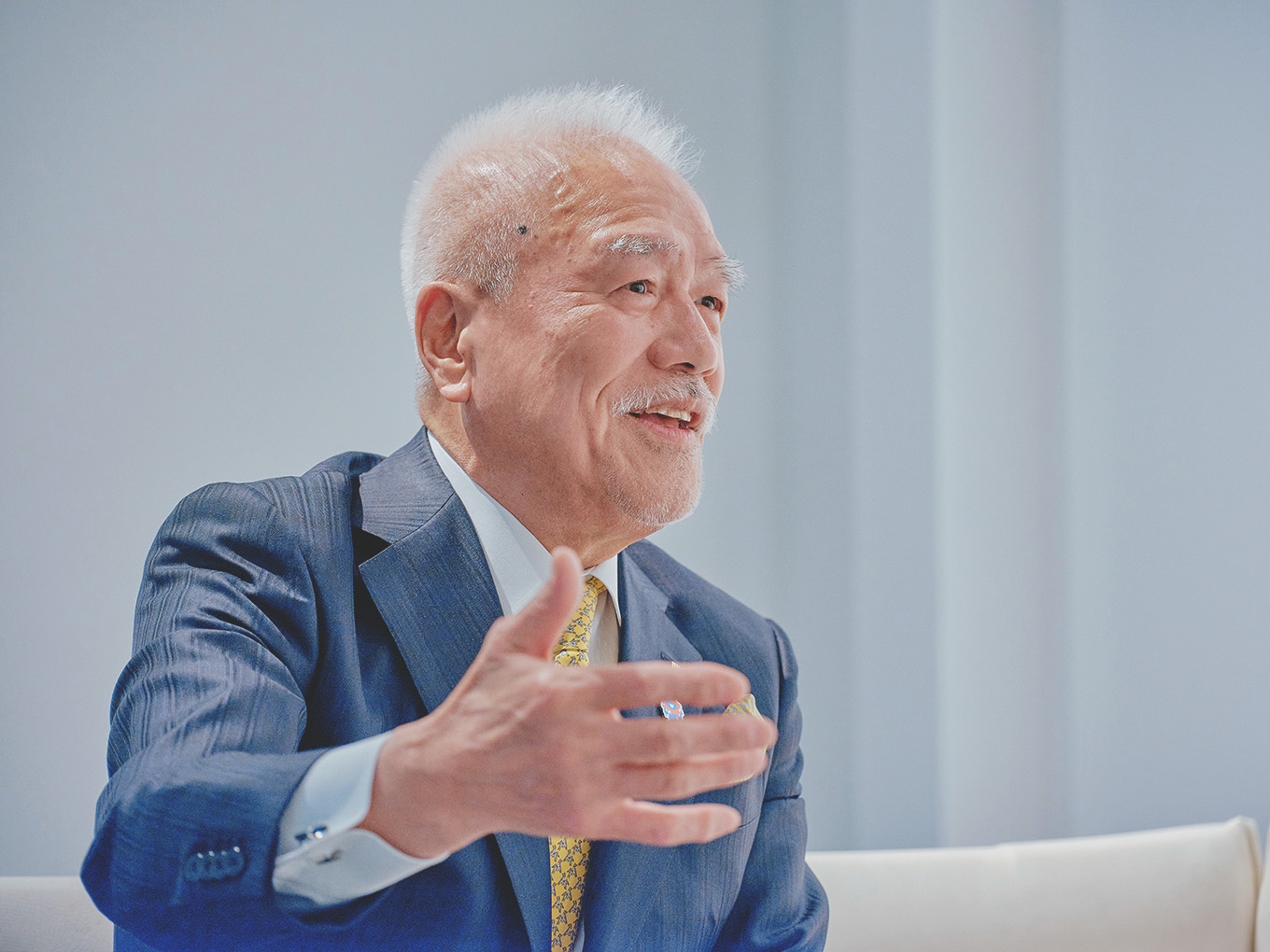
TATENO
Why did you choose the “Intertwining Our Lives” theme for your pavilion?
KOYAMA
I originally wanted to use the word “Connecting Lives,” but since that was already being used in the Expo’s overall theme, I chose ‘intertwining’ instead.
TATENO
That’s interesting. As a thatched pavilion, it is certainly a wonderful structure. I heard that architect Kengo Kuma was also involved. Did you come up with the idea together?
KOYAMA
I work with Kuma on a regular basis across various projects, so we already get along well. But I wanted the younger members of his agency to come up with the plans.
TATENO
Aha, the young people!
KOYAMA
When we asked who wanted to submit ideas, 50 people came forward. Kuma and I narrowed the 50 proposals down to 10 and asked for those ones to be presented. The result was our decision to go with a thatched roof.
TATENO
A thatched roof is interesting. It is part of Japan’s origins.
KOYAMA
It is also a symbol of a society that recycles, as well as being iconic in the image of a village. I thought using thatch would be a good way to convey ideas that we need more than ever in current times. For example, while one family is thatching a home, other families come over to help. It’s also a reminder that craftsmen are still making thatched roofs all over the country.
TATENO
If we don't create such opportunities for the art of thatching, we will increasingly lose our craftsmen. When the expo is over, I'm sure there will be some people, even from other countries, who will want to use the thatch again. It would be a waste to throw it all away.
KOYAMA
We've already received requests from various places to have the thatch. It would certainly be nice if some went to people from other countries.
TATENO
I think people from other countries admire such materials. I note that the theme of the pavilion is food. Was that an idea you had from the very beginning?
KOYAMA
When I was first approached by the Expo Association, they asked me what I would like to do as a theme, and I immediately told them it would be something around food.
TATENO
I understand you have always loved food.
KOYAMA
Yes. Food is the root of life, and eating is to live. We receive it from the life of other living things. So, I wanted to create an opportunity for people to stop and think about what it means to eat and to talk about food as more than something that is simply delicious. When people do this, they feel a sense of gratitude, a humbler sense of appreciation.
TATENO
That's right. In the past, we knew that our food required the farmer’s labor. We were told that even a single grain of rice left uneaten was a waste. People don't say that anymore.
KOYAMA
Also, we live in an era where only some farm producers attract attention. The spotlight is always on those using unique production methods or trying something new, whereas producers who deliver rice to Japan Agricultural Cooperatives (the JA), for example, get scant attention, even though they make similar efforts.
TATENO
They certainly don't stand out.
KOYAMA
Our thatched roof pavilion has been created in the hope of providing an opportunity to foster a sense of gratitude for those lesser-known producers. It's called ‘EARTH MART’ and the concept is like a supermarket.
TATENO
That's an interesting concept. Can you explain it further?
KOYAMA
In our daily lives, I think that modern supermarkets create the greatest separation between food and life. The food may look delicious, but they don't understand it to be ‘life’ itself. Likewise, while consumers know they are buying a tasty product, they don't connect it to living things.
TATENO
Right. What we see stacked all along the market is, in fact, a vast shelf-load of living things.
KOYAMA
Yes, that's why I hope the visitors to our EARTH MART pavilion, having understood that what we eat is life, will remember that sense of appreciation afterwards. Next time they go to their local supermarket I want them to remember and be able to think “Yes, these products are life”.
TATENO
I think that's a wonderful idea.
KOYAMA
And, personally, I really like supermarkets. Pavilions on the theme of “Life” tend to have a very strong message and can sound a little too preachy. I came up with the ‘mart’ concept because I wanted to excite people when they visit the pavilion.
TATENO
What is it like inside?
KOYAMA
It is divided into two market floors: the “inochi no uriba” (Marketplace of Life) and the “mirai no uriba” (Marketplace of the Future). The life area is a market space to make people aware of the volume of other living things ingested within a single human life span of between 80 and 90 years. The space is designed to help people comprehend this.
TATENO
Hearing that already makes me interested. What about the future mart?
KOYAMA
That space looks at the future. It shows what food will be like in the future and what we should be focused on.
TATENO
In our present age, the traditional custom of giving thanks before we eat or ending a meal with the phrase “gochisou-sama” (thank you for that great meal) seems to be dying out. In that sense alone, it would be good if young people - children in particular - could visit the exhibition and be moved by it.
KOYAMA
We are trying in various ways to make people understand more deeply the reality that it is other living things that keep us alive. It has been calculated, for example, that a Japanese person eats an average of 28,000 eggs during his or her lifetime.
TATENO
Do people eat that much?
KOYAMA
Yes. But instead of just telling people the quantity I thought it would be better to show them what that huge number of eggs looks like. So, we are displaying 28,000 eggs like a chandelier. The visitors can stand below and have their photo taken with mouth wide open. You will have an image of you and all the eggs you will eat in your lifetime.
TATENO
That's a unique idea.
KOYAMA
I also want people to think about animal livestock. Livestock are born to keep people alive, so they are born to die. We take eating meat for granted but I hope that through imagery we can show how meat also once had a mother and how it looked when it was born. As a result, I hope people will feel the weight of being the recipient of that life.
TATENO
I think we will have to face times of food shortage, so it is very important to draw attention to such things now.
KOYAMA
Yes. I spent five years preparing this pavilion and thinking about such things, so I am confident that when, at mealtimes, I say “Itadakimasu / I humbly receive” I do so with more soul than anyone else. *Laughs*
TATENO
I'm sure you really do. *Laughs*
KOYAMA
The word “Itadakimasu” expresses our gratitude for being given life. It also expresses thanks to the people who produce the food, to those who transport it, to the loved ones who prepare it, or the cooks and other people behind the scenes. The more we think about how we receive our food, the more we naturally feel grateful and humble. If more of us can develop such feeling, it will lead to a better future.
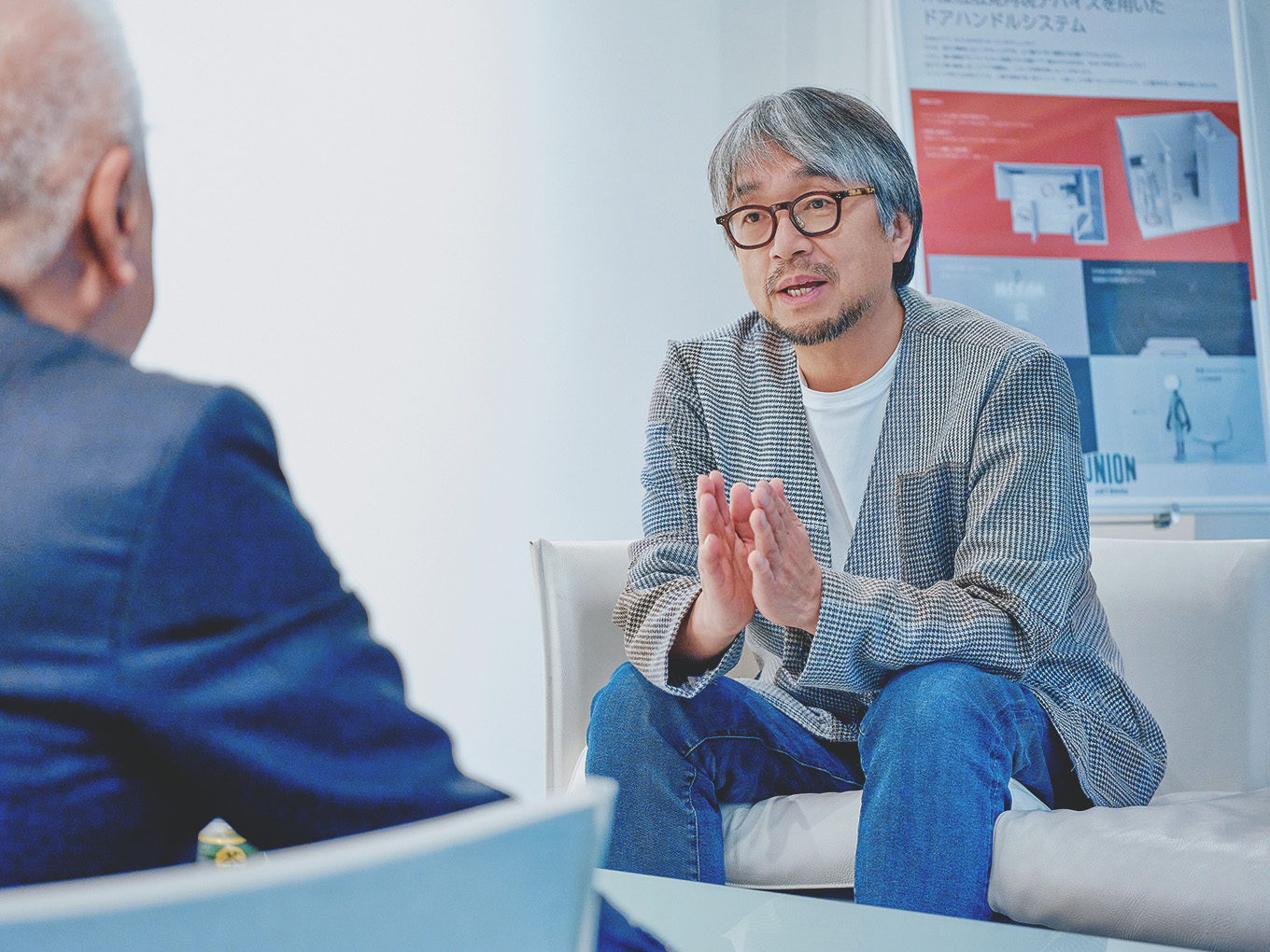
TATENO
It seems to me that we can learn to be more considerate of one another. I hope that by visiting the pavilion people will gain an awareness of this, especially in the present age where we spend so much time gazing down at smart phones that we don't even know what the person next to us is doing. By the way I read your book “Resetting Our Thinking Technique”.
KOYAMA
I originally wrote that for junior high school students. Then the publisher wanted adults to read it also, so I changed the title and it was republished.
TATENO
I read it with great interest. I think your book describes exactly what we need in the present age. How long ago did you write it?
KOYAMA
That was more than 10 years ago.
TATENO
Well, I feel it’s a narrative still very relevant now. You talked about smartphones. Indeed, if all people do is stare into their phones, they don’t notice when there's a rainbow in the sky, or even if the environment around them has changed. They don't notice anything at all. It’s not a good thing to be so reliant on such convenient things.
KOYAMA
It’s the same with this World Expo. When we talk about evolution and progress, we think of them in the sense of things that bring us more convenience. Flying cars are being developed and smartphones are evolving, but I think there is a difference between convenience and happiness.
TATENO
I agree.
KOYAMA
I think that when people begin to adopt a “convenience = happiness” mindset, they actually end up feeling less happy. So, I think we all need to make a distinction between convenience and happiness.
TATENO
I see. Certainly, we cannot know if smartphones have been beneficial to our lives overall until some years have passed and we look back.
KOYAMA
That's why it would be good to properly define what true happiness is in our current age. To change the subject a little, when I was invited by UNION for this discussion, I hadn’t realized that a company can build an entire business from door handles alone.
TATENO
Everyone thinks that. *Laughs*
KOYAMA
I thought “that’s amazing”. I’m interested to know how UNION was established and how it became what it is today.
TATENO
The story begins with my predecessor working on projects for the 1964 Tokyo Olympics and, subsequently, Osaka Expo ‘70. The country’s prestige was very much on the line. We responded to each architect’s order individually. UNION’s response was flexible in terms of, for example, quality and delivery time. This was a key factor in gaining customer trust and building our brand.
KOYAMA
Were there other companies in your industry?
TATENO
Yes. There were others but, before we knew it, we were the only ones in Japan, and we have survived to this day.
KOYAMA
When I think about it, the first thing we touch when we get home is our door handle. So, if the door handle feels comfortable...
TATENO
That's exactly what I tell my employees. After a new building has been put up, when you find the door handle at its entrance is something that you made, it’s immensely satisfying.
KOYAMA
I live in an old condominium in Kyoto which is now almost 50 years old. A few years ago, we carried out a major renovation. We changed various things in the communal areas such as the entrance and mailboxes and we also decided to change the doors to our individual apartments. Until then, the door handles were small and poorly designed. Every time I came home, I used to think, “This is just so shabby”.
TATENO
And it’s something you do every day.
KOYAMA
The interiors had been remodeled from their skeleton and were very clean, but I was not at all happy with the door. When it was replaced with a model that closed with a more solid ‘clank’, I felt my home had become a much nicer place.
TATENO
I’m glad to hear you say that. Doors are a major element of a house. But in my opinion, all condominiums tend to have the same door style. It would be much better if they were all different. That would make each apartment feel more like a private residence.
KOYAMA
That is a good idea, and it reminds me of something. On a Venetian gondola, the wooden oar-post used to rest and lock the single oar is called ‘a forcola’. There are craftsmen who make nothing but forcola oar-posts, and the bestdesign for hooking into and paddling with is a big debate.
TATENO
I didn’t know there was a world of such craftsmen.
KOYAMA
Yes, there is. And as you go around the city you can tell which houses are owned by gondola craftsmen because they use their surplus forcola oar-posts as door handles It’s nice to see such individuality in the houses.
TATENO
At this year's Expo, the door handles around the gas pavilion are gas pipes. As you said, the door handle is the first thing people touch, so our people place great importance on how the handle feels to the touch, etc. Even when a design is to be mass produced, we tell our craftsmen to preserve the handmade feel.
KOYAMA
That sounds right. If it were a chef's house, you could put a knife handle on the door... Then again, if you don't want to be reminded of work when you get home, it might be better to use something different. *Laughs*
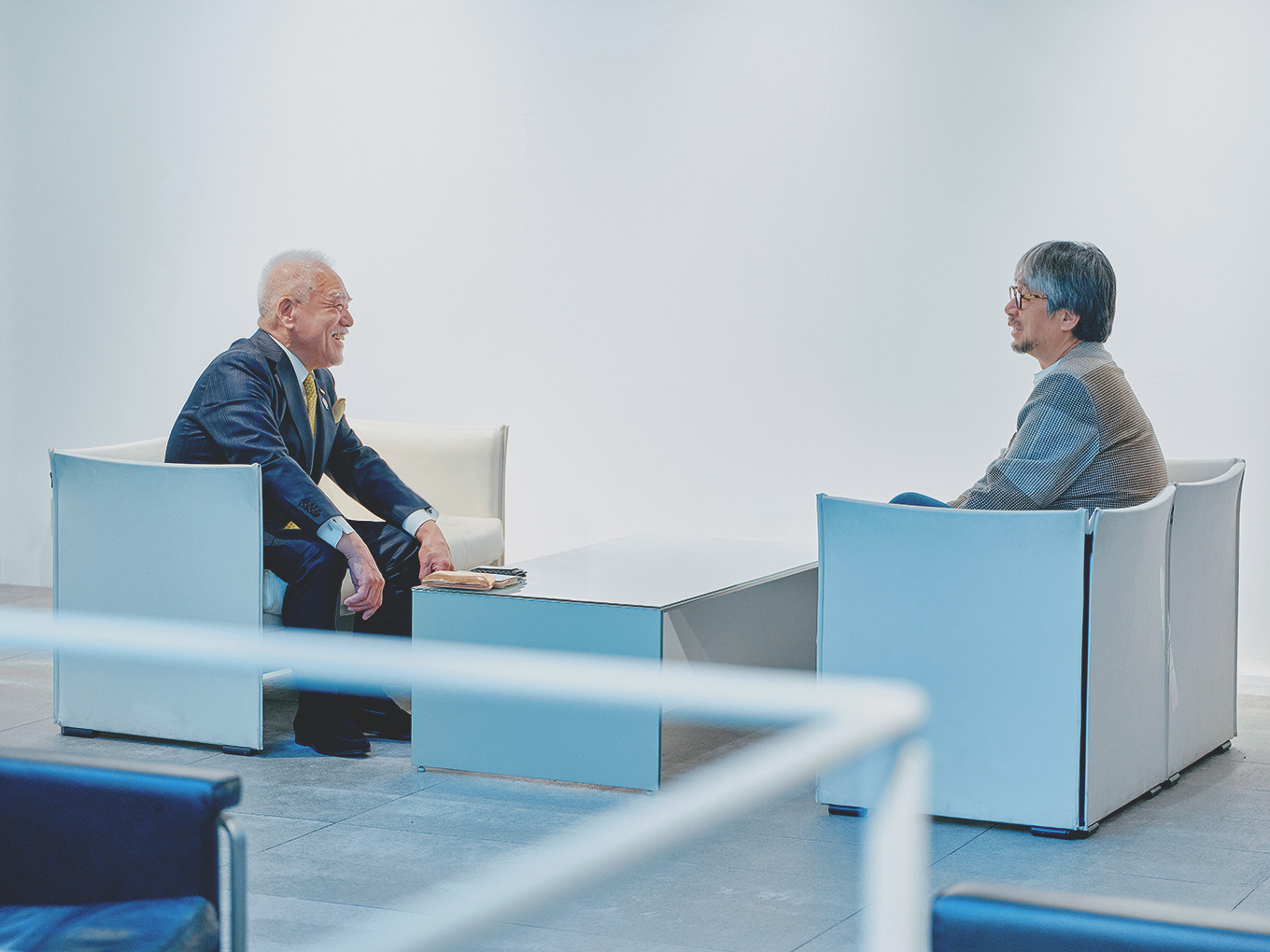
TATENO
You have been involved in various TV productions, for example, you used to work on Iron Chef which was a very interesting show. What is your approach to projects?
KOYAMA
There are three things I always ask myself. “Is the idea new? Is it fun for me? Does it make other people happy?” It isn’t easy to achieve all three, but I tell myself that, even if I only achieve one, then the work will be worthwhile. Of the three, I’m most concerned whether my work will lead to other people’s happiness.
TATENO
That’s a great attitude.
KOYAMA
When I create content, I first think about who or what I want to shine a spotlight on. For example, in the movie Departures (Okuribito) I focused on the ‘noukan-shi’, (the casket-making profession) hoping that more people might take an interest in that line of work.
TATENO
People don't usually give a thought to jobs like that do they?
KOYAMA
Not at all. The media inevitably aims its’ spotlight on things that are already lit up. I, however, believe we should shine the light on subjects that people have not yet noticed. I think it should be the mission of the media to draw attention to the less visible people, places, and jobs.
TATENO
Yes, I think so too. Furthermore, I think it is important to create new work for people after spotlighting their profession. For example, traditional Japanese houses are rarely built these days, so carpenters have fewer opportunities to actively practice their craft. That is why I think the ‘Shikinen Sengu’ (periodical renewal) of Ise Jingu shrine - which is rebuilt every 20 years - is a well-designed system. It has successfully preserved the profession and skills of the shrine carpenter down to the present. Even when it comes to making the brass for our door handles, the process is no longer carried out in Japan.
KOYAMA
Really? I didn’t know that.
TATENO
Whether it’s a master carpenter or a top chef, craftsmen have always passed their skills down through great effort and hard work. If we do not offer work to these traditional craftspeople and encourage them to continue, I fear they will all disappear eventually.
KOYAMA
I understand. But there are some things that do need to go because they no longer suit the times. So, I think that things that need to change must change.
TATENO
Yes, you are right about that.
KOYAMA
For the past several years, I have been a judge for Fukushima Prefecture's design awards in what is called the “Fukushima Best Design Competition”. The contest gives awards for products, such as souvenirs and local items made by Fukushima Prefecture businesses. The design criteria used relate to ‘packaging’, ‘naming’ and ‘product planning’
TATENO
Directing the spotlight on Fukushima is a wonderful project.
KOYAMA
Thank you very much. The grand prize this year went to a recyclable plastic cup made from sugarcane. The design is stylish, sufficiently sturdy, and the cups can be washed and re-used many times. They cost 550 yen for 5 pieces.
TATENO
It sounds very cost-effective.
KOYAMA
The judges thought it was such a good idea. The best thing was that the cups were made by a lacquerware store. I think it’s great that a lacquerware business that has only ever sold lacquer products, and would typically dislike a material like plastic, can also develop a sugarcane product. They know that selling lacquerware alone will not be enough in the future.
TATENO
They have made efforts to find a new way to survive.
KOYAMA
They will continue to sell lacquerware but will also include more and more of this kind of product. The cups might make an interesting new product if coated with lacquer. I think that would be a great idea.
TATENO
We too are collaborating with traditional crafts to make door handles and trying to market them overseas. We are also working on various combinations, using such things as lacquer, pot iron, ceramics, or weaving with Nishijin textiles.
KOYAMA
I teach at Kyoto University of Arts, and I’m also working on a project. My students go to traditional craftsmen where, together, they create products. They get to know them so well they are now like grandchildren. The best-selling products that resulted from the project have been the “hanao” shoes.
TATENO
What kind of shoes are they? They sound like shoes with clog straps.
KOYAMA
That’s exactly right. Hanao are straps or cords traditionally attached to Japanese ‘geta’ (wooden clogs) ‘zori’ (slip on sandals), etc. In fact, the number of craftsmen making hanao straps is in rapid decline. People simply don't wear clogs anymore. So, we are attaching hanao to white sneakers instead. It looks as if you are wearing traditional sandals with traditional tabi socks. Even Kyoto’s Geiko and Maiko performers in Gion have been wearing them recently. They are very comfortable to the feet.
TATENO
It’s great to be keeping the craftsmen in work.
KOYAMA
Hanao may only be a decoration for the shoes, but production has increased because it is a proper craftsman's work. We are also experimenting with having a tile craftsman make wooden ice cream spoons using tile-making techniques. I also think it would be interesting to have lacquer craftspeople manufacture the same object and then display the results side by side. Now I’m wondering if our students could make door handles for some project…
TATENO
Yes, certainly. We should work together sometime.
KOYAMA
Absolutely. I would really appreciate that.
TATENO
It could be a door handle, or other project to make architecture more interesting.
KOYAMA
I think my students would find that interesting too.
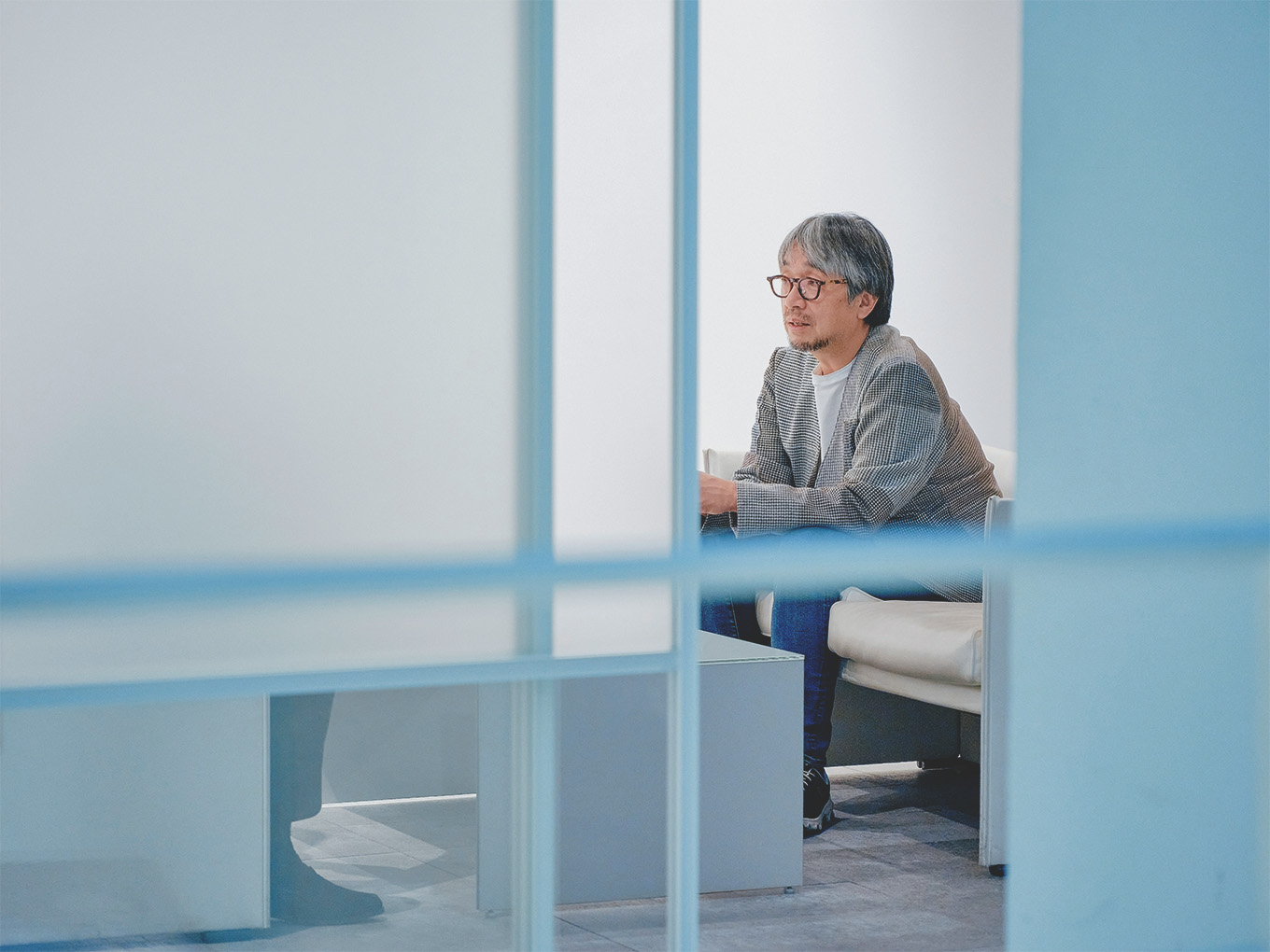
TATENO
I think it will be important to be different in the future, but is there anything you keep in mind when teaching students?
KOYAMA
I was talking with a stonecutter once and he told me something very profound. He said that when he builds a stone wall, he doesn’t only bring together beautiful stones. To make a good wall, you must have stones that fit neatly in the gaps between the finer stones. A good stone wall is determined by the number of different stones in combination.
TATENO
I see. Do you think the same applies to communities?
KOYAMA
Yes. It’s the same for companies and organizations. I think it’s good to have a variety of people-types, rather than just a group of exclusively top-graders. In our company, we often say, “we need some people who are more like the fatty meat,” instead of everyone being like a lean prime cut of Chateaubriand. If we don’t include the former, the meat becomes very dry. By having people with other ‘in between’ personalities we can be a hub for new thinking.
TATENO
I think the so-called GAFAM founders (Google, Apple, Facebook, Amazon, and Microsoft) are all like that. You don’t find many people as unusual as Elon Musk, in particular.
KOYAMA
Perhaps that’s because such people are more accepted in the United States.
TATENO
In Japan, the mavericks are generally pushed aside. But if we don’t accept them, new ideas and development will not come about. I think that, in the future, education will increasingly need to develop individuality. At my company, I tell our recruiters that, even if they don't think a person will fit in well “do try, now and then, to hire someone who stands out”.
KOYAMA
Unfortunately, governance is more of a factor nowadays, so that's not always easy.
TATENO
Certainly, there are some sensitive issues such as whether (or not) you can scold people during employee training.
KOYAMA
By the way, how is the Expo going in Osaka itself?
TATENO
There is a certain degree of excitement although that has not yet reached the national level. The Myaku-Myaku mascot character is becoming popular. When I first saw the mascot, I thought it was a little weird. But when I’ve shown it overseas, designers there have liked it.
KOYAMA
I was originally asked by a mascot specialist what kind of character I would want for the Expo. Since the chosen logo already had the suggestion of a character, I told him the mascot design should be based on the logo.
TATENO
I see, so that’s how it came about. Expo 2025 Osaka, Kansai will run until October of this year, and I’m looking forward to seeing the “Koyama Pavilion”, or as I should say, the “EARTH MART” pavilion? I also look forward to seeing what you will focus your spotlight on in the future.
KOYAMA
Thank you very much.
TATENO
Lastly, I would like to show you the ‘non-contact automatic door’ we will exhibit during the Expo. You can try it for yourself here and now, so please allow me to take you around.
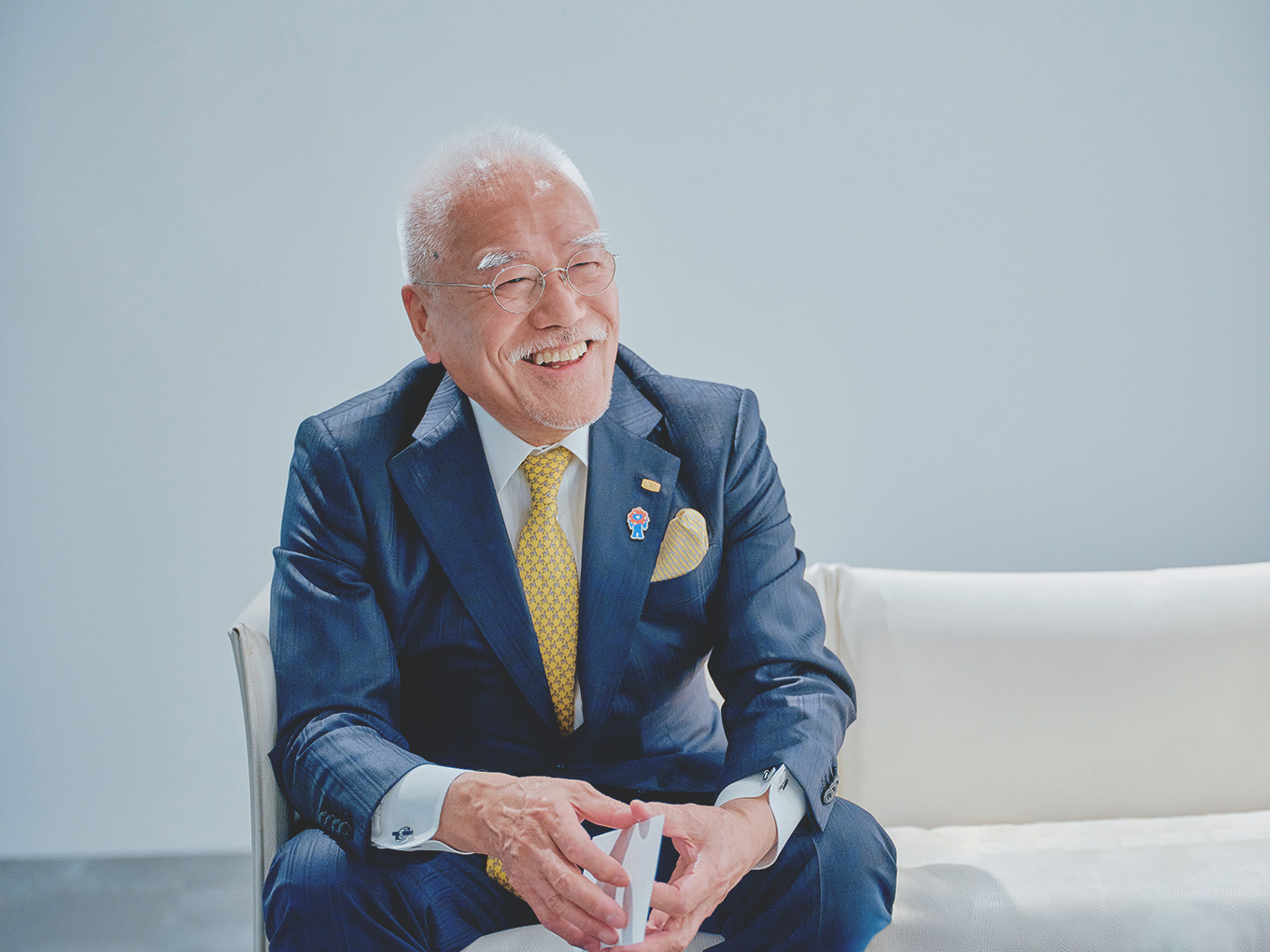
--------- Koyama-san’s Encounter with a Near-future Door Handle System.
[How UNION envisions doors in the future]
Automatic doors sometimes open and close in a way we don’t expect. That can be an uncomfortable experience. Since the Covid pandemic, more and more people have come to dislike the contact required by touch-type automatic doors. So, what should a future door look like? UNION believes this is not something to be solved by the evolution of AI and ‘OPEN / CLOSE’ sensors. The solution will be found in allowing people to be instinctively human and in the human mind pioneering beyond boundaries.
[Having the Control to Open a Door, Without Physical Contact]
The User can extend his or her hand to grab a 3D virtual handle image and, thanks to non-contact tactile-reproducing technology, push it to open a real-world physical door. Sensors can also measure the User’s posture, blood pressure, body temperature, and heart rate. This means that, connected to your door at home, the system can also help you monitor daily health. The system was developed in collaboration with Tokyo startup TENGUN LABEL. It will be exhibited at Expo 2025 Osaka, Kansai.
[A Feedback Comment from Kundo Koyama]
I had never imagined that in updating a humble door fixture, something we unconsciously touch every day, so many doors to the future could be opened.
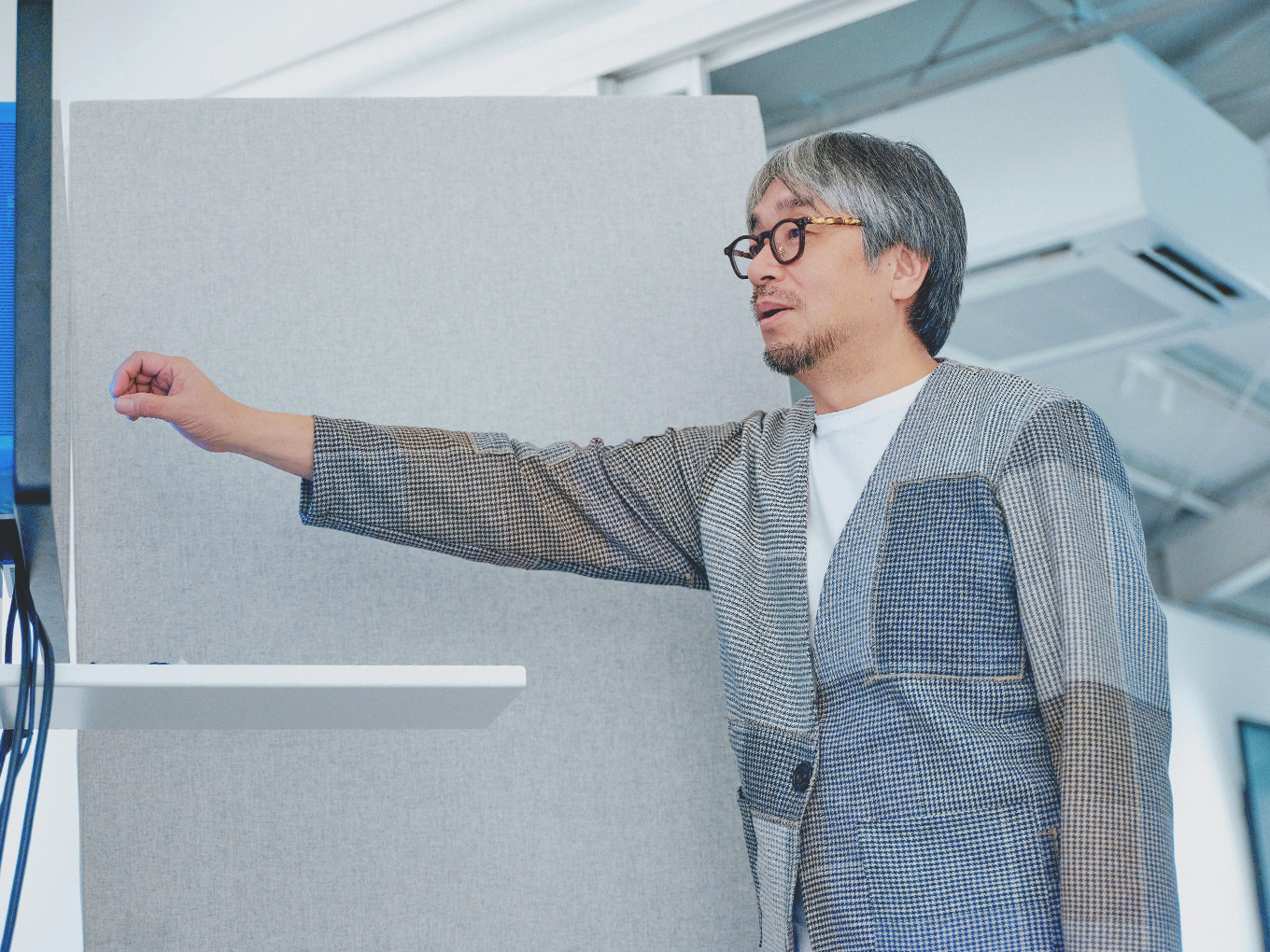
Planning:Naoyuki Miyamoto
Photography:Naoto Nishimoto
Writing:Naoki Moritani
Web Direction : Tomoko Yoshimura